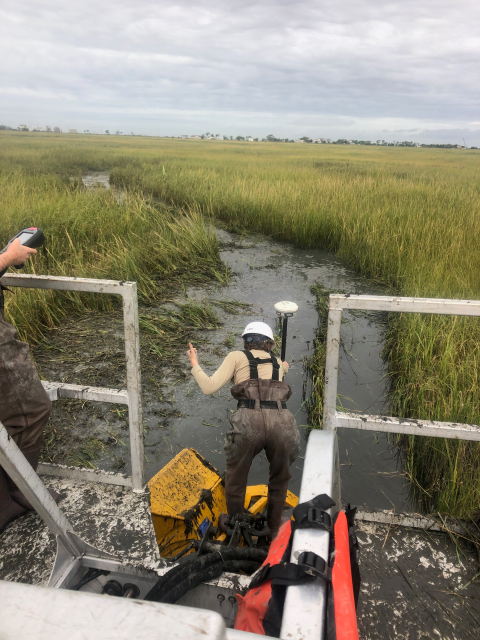Brian Braudis likes to begin with the end in mind.
That’s precisely what he did when he saw an opportunity to solve a long-standing problem damaging salt marsh salt marsh
Salt marshes are found in tidal areas near the coast, where freshwater mixes with saltwater.
Learn more about salt marsh at New Jersey’s Cape May National Wildlife Refuge, where Braudis is refuge manager.
His strategy: Use federal funding for Hurricane Sandy recovery to plan for a large-scale marsh restoration — bigger than the funding allowed — then look for an opportunity with partners to finish the work.
The approach paid off. This September, the Service and partners, including Ducks Unlimited and the Friends of Cape May National Wildlife Refuge, completed the full 100-acre project to improve the marsh’s poorly functioning drainage system for the benefit of nature and people.
“A healthy, fully resilient marsh provides important habitat for waterfowl, wading birds, shorebirds, and other wildlife,” Braudis said. “It’s also able to absorb storm energy and increased water levels, lessening the chance of coastal flooding in communities nearby.”
The 100 acres in question are part of the refuge’s Reeds Beach parcel, located along Delaware Bay in Cape May County.
Looking for answers
Well before Hurricane Sandy struck the Atlantic Coast in 2012, Cape May Refuge staff had noticed the Reeds Beach tidal marsh was suffering from a form of “dieback” — a phenomenon that’s been documented in many Northeast and Mid-Atlantic coastal states.
“Bald spots where vegetation — sometimes called dieback — won’t grow are a big deal,” Braudis said. “When marshes have too much of this, they’re not useful. There’s no habitat. They’re not resilient. Because there are no roots, nothing stopping the water, the tide acts like sheet wash and slides in and slides out of the marsh, creating erosion and other problems.”
Starting with the end in mind, Braudis and his team invested Hurricane Sandy funds to tackle the vegetation death at Reeds Beach. Cape May Refuge received $1.9 million in Hurricane Sandy recovery and resilience funds for salt marsh restoration.
“The idea was to create a sort of cookbook — for ourselves so we could do the larger area and for other people so they could use our models at other locations,” Braudis said.
The problem: A team of Service staffers, contractors, and partners conducted extensive research at the site and discovered the marsh was staying too wet. The amount of tide going in was greater than the amount going out, and the water left behind was effectively drowning some of the vegetation.
The reason: historical uses such as salt hay farming and mosquito-control ditches cut through the marsh had disrupted the site’s hydrology.
The remedy: The team designed and, in 2017, built narrow, winding channels called runnels on about 48 acres of the 100-acre site to drain pooled water off the marsh surface.
These runnels lead to larger channels that allow the excess water to run back out to sea, leaving a higher and drier marsh.
A little help from our friends
Initial observations were positive, with new plants taking root in areas that were previously bare. Still, there were 52 acres of marsh in need of work.
Fortunately, the innovative project had admirers; one was Ducks Unlimited.
“Wetland health is what Ducks Unlimited is all about,” said Jim Feaga, Ducks Unlimited regional biologist for Pennsylvania, New Jersey, Long Island, and coastal Connecticut, “and there was a clear need for additional support to continue the project.”
In fact, the Reeds Beach marsh resiliency project is one of three Service projects in New Jersey that Ducks Unlimited has been supporting. Others are at Supawna Meadows National Wildlife Refuge and Edwin B. Forsythe National Wildlife Refuge.
“These projects tie back into one of our priority species, the American black duck,” Feaga said. “We’re trying to create more resilience and restore impaired marshes specifically to benefit black duck populations.”
“We look at black ducks and waterfowl in general as umbrella species that benefit a whole host of endangered and protected species,” Feaga said.
Ducks Unlimited has provided direct funding and in-kind support for the projects. At Reeds Beach, Feaga worked with Service staff to leverage Ducks Unlimited support and secure a grant awarded through the Delaware Watershed Conservation Fund, administered by the National Fish and Wildlife Foundation.
“The ecosystem services these coastal wetlands provide are hugely important,” said Feaga. “Restoring wetlands is part of a big picture of habitat, economy, and health and human safety.”
Benefiting the elements of this big picture is just the kind of ending we need.






